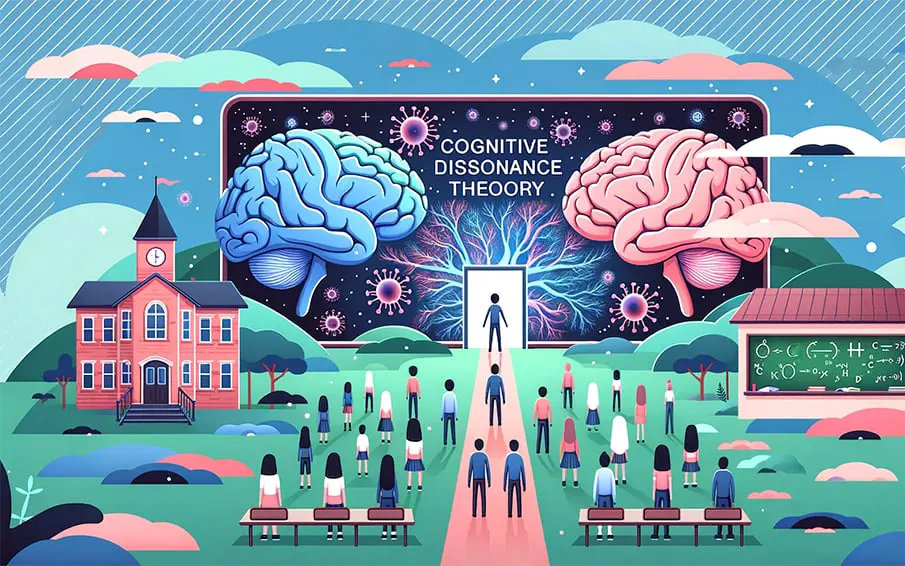In the digital age, the convergence of psychology and education is evident more than ever. This comprehensive guide explores how the cognitive dissonance theory can be harmoniously integrated into eLearning environments, fostering an ecosystem where learning is both profound and engaging.

Understanding Cognitive Dissonance: A Prerequisite for Effective eLearning
Before we delve into the intricacies of cognitive dissonance, it is essential to understand its role and significance in the realm of eLearning. This section serves as a gateway to comprehending the profound impact cognitive dissonance can have in shaping effective and empathetic eLearning experiences.
Defining the Foundations: Cognitive Dissonance Definition
To navigate the complex terrain of cognitive dissonance, we first need to define it clearly. Cognitive dissonance represents a psychological conflict stemming from simultaneously holding conflicting beliefs or values. This phenomenon can create a kind of mental turbulence, prompting individuals to seek harmony and consistency in their beliefs and actions. Within eLearning spaces, an understanding of the cognitive dissonance definition can form the cornerstone of fostering environments that encourage critical thinking and fruitful dialogue.
What is Cognitive Dissonance
Exploring the question, “What is cognitive dissonance?” is crucial in the broader discourse surrounding psychology and human behavior. In the scope of eLearning, cognitive dissonance can manifest when learners encounter novel information that stands in contradiction to their pre-existing beliefs or knowledge. By acknowledging and addressing cognitive dissonance, educators can design learning experiences that are more engaging and facilitate a deeper understanding and retention of the material.
The Interplay of Cognitive Dissonance in eLearning
As we delve deeper into the nexus of cognitive dissonance and eLearning, it becomes apparent that this psychological theory has substantial implications in the digital education space. Understanding the nuanced ways in which cognitive dissonance interacts with eLearning dynamics can pave the way for more inclusive and insightful educational experiences.
Cognitive Dissonance Examples in eLearning Scenarios
Analyzing cognitive dissonance examples offers a rich perspective on its profound influence on eLearning dynamics. Here are some instances where cognitive dissonance might significantly affect the learning experience:
- Encountering conflicting information in various course materials, fostering confusion and potential mistrust towards the content.
- The struggle to integrate new knowledge with established beliefs, creating hesitation in accepting the fresh information fully.
- Reluctance in adapting to new technologies or learning platforms, especially if one has a strong affinity for traditional learning methods.
Through these examples of cognitive dissonance, educators can identify potential learning barriers and strategize to overcome them effectively.
Unraveling the Cognitive Dissonance Meaning in Digital Education
The cognitive dissonance meaning in digital education is substantial, encapsulating various dimensions that influence learner engagement and content perception. In this section, we explore the multifaceted role of cognitive dissonance in shaping online discussions, impacting student motivation, and potentially altering the learner’s interaction with digital content.
Strategies to Mitigate Cognitive Dissonance in eLearning
Addressing cognitive dissonance within eLearning environments necessitates a comprehensive strategy that includes both educators and learners. This section outlines a series of actionable strategies that can be employed to minimize the adverse effects of cognitive dissonance and foster a more harmonious learning experience.
Identifying and Addressing Cognitive Dissonance: Tips for Educators
Educators play a pivotal role in identifying and mitigating cognitive dissonance within the learning environment. Here are some insightful strategies that educators can employ to foster a positive and inclusive learning space:
- Encourage open dialogue, facilitating discussions around conflicting beliefs and viewpoints.
- Provide resources to help learners reconcile conflicting information and form well-informed opinions.
- Implement teaching methodologies that nurture critical thinking, empowering learners to analyze information from multiple perspectives.
Cognitive Dissonance Theory Applied: Strategies for Learners
Assisting learners in navigating the complex landscape of cognitive dissonance involves providing support and fostering the development of critical thinking skills. Here, we detail several strategies aimed at empowering learners to address and overcome cognitive dissonance:
- Offer guidance in navigating complex topics, fostering an environment that encourages curiosity and exploration.
- Encourage the development of critical thinking skills, facilitating a deeper and more nuanced analysis of the information presented.
- Promote a culture of continuous learning and adaptation, preparing learners to successfully navigate the dynamic landscape of digital education.
Case Studies: Examples of Cognitive Dissonance Resolutions in eLearning
Exploring real-world case studies offers a glimpse into the successful integration and mitigation of cognitive dissonance within eLearning environments. In this section, we delve into illustrative examples showcasing how educational institutions have successfully addressed cognitive dissonance, fostering enriched learning experiences.
Success Story 1: An Example of Overcoming Cognitive Dissonance
In this case study, we examine how a renowned educational institution effectively alleviated cognitive dissonance among learners. Through fostering open dialogues and providing resources to reconcile conflicting information, learners were guided towards a harmonious learning journey. This approach facilitated a deeper understanding of complex subjects, nurturing a culture of empathy and understanding.
Success Story 2: Strategies Employed to Reduce Cognitive Dissonance
This case highlights a compelling narrative where strategic measures helped reduce cognitive dissonance, fostering a more inclusive and empathetic learning environment. The implemented teaching methodologies encouraged critical thinking and open dialogue, equipping learners to navigate complex terrains of conflicting information with a nuanced understanding of the subject matter.
Conclusion: Future Directions of Cognitive Dissonance and eLearning
As we stand at the intersection of cognitive dissonance theory and eLearning, it becomes evident that the future holds promising avenues for integrating these two realms seamlessly. This concluding section reflects on the potential trajectories and the central role cognitive dissonance theory will play in shaping enriching, engaging, and immersive eLearning experiences in the years to come.


